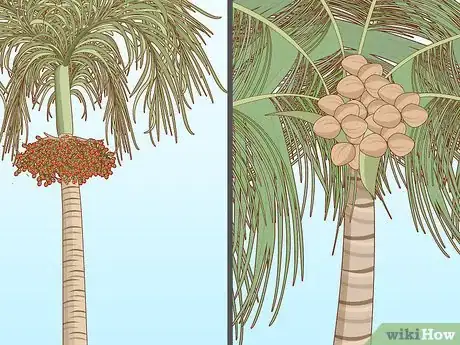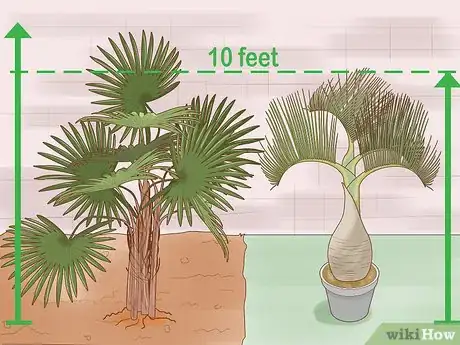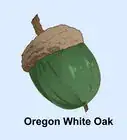This article was co-authored by Michael Simpson, PhD. Dr. Michael Simpson (Mike) is a Registered Professional Biologist in British Columbia, Canada. He has over 20 years of experience in ecology research and professional practice in Britain and North America, with an emphasis on plants and biological diversity. Mike also specializes in science communication and providing education and technical support for ecology projects. Mike received a BSc with honors in Ecology and an MA in Society, Science, and Nature from The University of Lancaster in England as well as a Ph.D. from the University of Alberta. He has worked in British, North American, and South American ecosystems, and with First Nations communities, non-profits, government, academia, and industry.
This article has been viewed 255,583 times.
Palm trees are so named because many of them feature fan-shaped, or palmate, fronds. There are over 2,600 species of palm trees, including some that can withstand temperate climates with cold winters. The distinguishing characteristics of palm trees are their fronds, trunks, height and growth rates, and their stems.
Steps
Recognizing Important Palm Tree Characteristics
-
1
-
2Examine the fronds.[3] The best way to begin classifying your palm tree is based on the fronds. Some palm trees have feather-like fronds, while others have fan-like leaves. Both types of frond can range from green to blue-green to silvery.[4]
- Feather-like fronds (pinnate) are found on some of the most popular and common palm tree types like the Areca Palm, Coconut Palm, Queen Palm, and Date Palm.
- If the tree has fan-like leaves, the most common are the Bismarck Palm, Mexican Fan Palm, and Windmill Palm.
Advertisement -
3Examine the tree for fruit. Palm trees are commonly associated with tropics, but not for the fruit they bear. Coconuts, acai berries, and betel nuts are all from palm trees, so if you find these fruit, you can be sure you've found a palm tree.[5]
-
4Look at the trunk closely. Palms have either a solitary or multi-trunk, which appears like a cluster of trunks woven together.[6] Typically multi-trunk palms are shorter and have a longer maturation period. Common multi-trunk varieties are the Needle Palm, Lady Palm, and Areca Palm. These often appear more like shrubs than tall slender trees. Coconut or Date Palms are single trunk and much taller than the shorter, shrub variety.[7]
- The surface of these trunks vary, too. Some are smooth whereas others have leaf bases layered in a criss-cross pattern. Most palm trees have straight trunks but other common varieties like the Coconut Palm have tapered trunks.
-
5Identify the tree's flowers. Palm trees are distinguished by very discreet flowers that are usually yellowish-green to light green and generally grow in clusters along the stems. They are generally not very vibrant or flashy.
- Some common distinguishable flowers include: the Areca Palm with bright yellow flowers, the Bottle Palm with small white flowers, and the Coconut Palm with sweet-scented yellow flowers.[8]
-
6Estimate the tree's size.[9] Once you've narrowed down other distinguishing marks like the fronds and trunk, you can use the size of the tree to further narrow down the possibilities. In order to distinguish from one variety to another, the tree will need to be mature. When palm trees are only a few months old they all virtually look the same.[10]
- There are some dwarf varieties that only reach 10 feet (3.0 m) while others can grow as large as 100 feet (30 m).
Identifying Common Palm Tree Species
-
1Check the USDA hardiness zone for your area. The United States Department of Agriculture (USDA) divides the country into different hardiness zones based on the temperatures and weather conditions in which vegetation is likely to thrive. Compare the characteristics of the palm with the descriptions of the palms that can be grown in your zone. Some palms will only thrive in zone 11, while some can be grown as far north as zone 7.[11]
-
2Look for distinguishing features like drooping fronds or bright vivid fruit. There are so many types of Palm Trees so it's important to first look for anything that may distinguish one variety from another. You can do this by first looking for anything that may really stand out and that makes a certain variety very unique.[12]
- Coconut palms have single gray trunks and long pinnate leaves, but they are most distinguishable for growing coconuts, which they do all year long for up to 80 years. Wild coconut palms may grow up to 100 feet (30 meters) tall but they are much shorter when cultivated.
- Chinese fan palms, or fountain palms, are known for the drooping ends of palmate fronds. They have short, fat trunks that are gray and marked with scars of old fronds. The petioles are thorny and the fronds range in color from blue-green to olive green. Fronds may be as much as 5 feet (1.5 meters) wide.
- Carpentaria palms consist of pinnate leaves atop a slender gray trunk marked with scars of old fronds. They are most distinguishable by the bright red fruits that grow in clusters beginning when the palm is about 6 years old.
-
3Identify trees based on short size. The common image of a palm tree is a towering, slender tree found on beaches. However, some palms will never reach more than 10 feet tall. If you have a mature palm, you can narrow varieties down based on height.[13]
- Bottle palms or dwarf palms are so named because of their bottle-shaped trunks covered with the ends of old fronds. They seldom grow taller than 10 feet (3 meters) and are often seen in pots. Bottle palms have pinnate leaves.
- Lady palms grow slowly to heights of 10 feet (3 meters) outdoors. They may be as wide as they are tall because of multiple trunks. They have bright green or dark green palmate fronds, but the fronds are deeply divided, making them look like almost pinnate. The petioles have no thorns.
-
4Look for other common palm varieties that grow tall. If you come across a towering tree, it is likely to be one of the more common, tall varieties. These trees usually have a long maturation and will not reach their height until they have had many years to grow. If you see a tree that is over twenty feet tall, you can be sure that it is an older tree and that it is a tall variety of palm.[14]
- Queen palms grow as much as 6 feet (2 meters) a year to a maximum height of 40 feet (12 meters). Their trunks are singular, gray, and smooth with scars of old fronds. The fronds are dark green and pinnate, with doubled leaflets.
- Royal palms grow relatively quickly to heights up to 70 feet (21 meters). Their trunks are singular, gray, and marked with the scars of old fronds. The fronds are pinnate, dark green and may be as long as 10 feet (3 meters).
Expert Q&A
-
QuestionWhat are the tall skinny palm trees called?
 Michael Simpson, PhDDr. Michael Simpson (Mike) is a Registered Professional Biologist in British Columbia, Canada. He has over 20 years of experience in ecology research and professional practice in Britain and North America, with an emphasis on plants and biological diversity. Mike also specializes in science communication and providing education and technical support for ecology projects. Mike received a BSc with honors in Ecology and an MA in Society, Science, and Nature from The University of Lancaster in England as well as a Ph.D. from the University of Alberta. He has worked in British, North American, and South American ecosystems, and with First Nations communities, non-profits, government, academia, and industry.
Michael Simpson, PhDDr. Michael Simpson (Mike) is a Registered Professional Biologist in British Columbia, Canada. He has over 20 years of experience in ecology research and professional practice in Britain and North America, with an emphasis on plants and biological diversity. Mike also specializes in science communication and providing education and technical support for ecology projects. Mike received a BSc with honors in Ecology and an MA in Society, Science, and Nature from The University of Lancaster in England as well as a Ph.D. from the University of Alberta. He has worked in British, North American, and South American ecosystems, and with First Nations communities, non-profits, government, academia, and industry.
Registered Professional Biologist Very few palm species grow taller than 100 ft, although the Quindío wax palm (Ceroxylon quindiuense) can reach heights of up to 200 ft. There are also climbing palms, including several hundred species of rattan.
Very few palm species grow taller than 100 ft, although the Quindío wax palm (Ceroxylon quindiuense) can reach heights of up to 200 ft. There are also climbing palms, including several hundred species of rattan. -
QuestionDo palm trees have trunks?
 Michael Simpson, PhDDr. Michael Simpson (Mike) is a Registered Professional Biologist in British Columbia, Canada. He has over 20 years of experience in ecology research and professional practice in Britain and North America, with an emphasis on plants and biological diversity. Mike also specializes in science communication and providing education and technical support for ecology projects. Mike received a BSc with honors in Ecology and an MA in Society, Science, and Nature from The University of Lancaster in England as well as a Ph.D. from the University of Alberta. He has worked in British, North American, and South American ecosystems, and with First Nations communities, non-profits, government, academia, and industry.
Michael Simpson, PhDDr. Michael Simpson (Mike) is a Registered Professional Biologist in British Columbia, Canada. He has over 20 years of experience in ecology research and professional practice in Britain and North America, with an emphasis on plants and biological diversity. Mike also specializes in science communication and providing education and technical support for ecology projects. Mike received a BSc with honors in Ecology and an MA in Society, Science, and Nature from The University of Lancaster in England as well as a Ph.D. from the University of Alberta. He has worked in British, North American, and South American ecosystems, and with First Nations communities, non-profits, government, academia, and industry.
Registered Professional Biologist Most species produce frond-like leaves clustered at the top of a rigid stem that serves the same function as a tree trunk. However, there are several species that are trunkless, such as the cat palm (Chamaedorea cataractarum).
Most species produce frond-like leaves clustered at the top of a rigid stem that serves the same function as a tree trunk. However, there are several species that are trunkless, such as the cat palm (Chamaedorea cataractarum). -
QuestionHow do I identify a small palm tree?
 Michael Simpson, PhDDr. Michael Simpson (Mike) is a Registered Professional Biologist in British Columbia, Canada. He has over 20 years of experience in ecology research and professional practice in Britain and North America, with an emphasis on plants and biological diversity. Mike also specializes in science communication and providing education and technical support for ecology projects. Mike received a BSc with honors in Ecology and an MA in Society, Science, and Nature from The University of Lancaster in England as well as a Ph.D. from the University of Alberta. He has worked in British, North American, and South American ecosystems, and with First Nations communities, non-profits, government, academia, and industry.
Michael Simpson, PhDDr. Michael Simpson (Mike) is a Registered Professional Biologist in British Columbia, Canada. He has over 20 years of experience in ecology research and professional practice in Britain and North America, with an emphasis on plants and biological diversity. Mike also specializes in science communication and providing education and technical support for ecology projects. Mike received a BSc with honors in Ecology and an MA in Society, Science, and Nature from The University of Lancaster in England as well as a Ph.D. from the University of Alberta. He has worked in British, North American, and South American ecosystems, and with First Nations communities, non-profits, government, academia, and industry.
Registered Professional Biologist If you are trying to identify a palm that has a trunk, check whether that trunk is smooth or rough in texture, or whether it has distinct remnants of where previous generations of leaves detached as it was growing. Estimating height might also help you narrow down the list of possible species.
If you are trying to identify a palm that has a trunk, check whether that trunk is smooth or rough in texture, or whether it has distinct remnants of where previous generations of leaves detached as it was growing. Estimating height might also help you narrow down the list of possible species.
References
- ↑ Michael Simpson, PhD. Registered Professional Biologist. Expert Interview. 8 September 2021.
- ↑ http://www.florida-palm-trees.com/identify-palm-trees/
- ↑ Michael Simpson, PhD. Registered Professional Biologist. Expert Interview. 8 September 2021.
- ↑ http://www.florida-palm-trees.com/identify-palm-trees/
- ↑ http://www.florida-palm-trees.com/identify-palm-trees/
- ↑ Michael Simpson, PhD. Registered Professional Biologist. Expert Interview. 8 September 2021.
- ↑ https://bustlingnest.com/palm-tree-types-identification/
- ↑ https://bustlingnest.com/palm-tree-types-identification/
- ↑ Michael Simpson, PhD. Registered Professional Biologist. Expert Interview. 8 September 2021.
- ↑ http://www.florida-palm-trees.com/identify-palm-trees/
- ↑ https://bustlingnest.com/palm-tree-types-identification/
- ↑ https://8billiontrees.com/trees/how-many-types-of-palm-trees-are-there/
- ↑ https://8billiontrees.com/trees/how-many-types-of-palm-trees-are-there/
- ↑ https://8billiontrees.com/trees/how-many-types-of-palm-trees-are-there/
About This Article
To identify different species of palm trees, start by examining the size and shape of the fronds and check to see if the tree has any fruit. Next, carefully inspect the trunk's appearance and height. After noting these specific features, you can enter the information into an online palm identifier or use a plant identification mobile app to determine exactly what species you're looking at. For example, if the tree has a tall, slender trunk, coconuts, and feather-shaped fronds, it’s likely a coconut palm. If the palm has fan-shaped fronds, spiny frond bases, and hairy fibers on its trunk, it’s probably a Mediterranean fan palm. To learn more about common physical characteristics of different palm species, read on!






































































